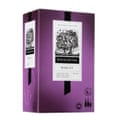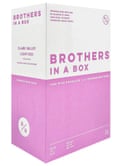
Goon sack, goon bag or, simply, goon. Cask wine is deeply ingrained in the Australian ethos and vernacular (it’s also an Australian invention), long associated with “two-buck chuck”, cheap wine for cooking or uni students on a budget. But its negative reception usually has nothing to do with the wine itself and more to do with the mistaken belief that price is an indicator of quality.
Now don’t mistake me, there are a lot of nondescript or terrible-tasting cask wines out there. But with the spotlight on the sustainability and carbon footprint of wineries, the appeal of boxed wine over glass bottles is becoming more prevalent.
For this taste test, I selected nine Australian-made red-wine casks with two important criteria: they had to be readily available online or at major bottle shops, and they had to come from existing wine labels or wineries – no supermarket “private labels”.
Joining me for this vinous showdown were two Sydney wine professionals, Stuart Knox, the owner of Fix Wine Bar, and Lily Horneman, the head sommelier of restaurant and bar Martinez. To assess the wines, we used the industry standard 100-point scale to judge the wine’s appearance (ideally vibrant red and purple hues, and nothing that resembles murky pond water), smell (ranging from fresh and aromatic to tired and faulty sour vinegar-like notes) and flavour (which covers texture, mouthfeel and if the wine exhibits characters inherent of its grape variety – this is what makes wine special and better than your average grape juice). A wine that scores 95 points and above is considered “gold”, 90 to 94 points is “silver”, 85 to 89 points is “bronze” and below 84 points is “no medal”.
The wines were tasted at room temperature, but most casks would benefit from being stored in the fridge. Overall we were delighted by the fruity purity across most of the casks. They are easy-drinking wines, and if we were in Europe and offered a house wine in a bistro or trattoria, these casks are very similar in style and quality (although it would most likely be served in a glass flagon rather than poured from a sack). But when it comes to Australian “chateau cardboard”, which ones should be proudly poured at the table – and which ones should be suspended from a Hills hoist?
Best overall
Cult Cru, 2022 grenache, McLaren Vale, South Australia, 2L, $39.99 ($2 per 100ml)
Score: 92/100
This was our highest-rated wine and the clear standout. While it’s not the cheapest nor the most expensive in the lineup, the grenache is very varietally specific (it tastes like a grenache) and delicious, as though you’ve just walked on the set of an Ocean Spray commercial and dunked your head into the vat of ripe cranberries. As he sipped, Knox commented on how easily this could be a “restaurant house wine, wine list” kind of wine. “I’m looking at this and thinking I could pour this here at the wine bar – no problem at all,” he said. This wine was singing at ambient room temperature and would be perfect propped up on the table next to a spread of charcuterie and beef tartare, as the vibrant red notes in this wine would balance out those “meatier” notes.
Best value
Winesmiths, 2022 merlot, South Australia, 2L, $13.99 ($0.70 per 100ml), available from major bottle shops
Score: 89/100
Horneman summed it up best: “Not your nan’s merlot, but she’d be so happy with it.” It will also bring happiness for those who want quality cask at a good price. This wine is juicy, with raspberry red fruits and a suppleness on the palate that’s reminiscent of slipping your hands into velvet gloves.
The rest
Gonzo Vino, 2023 ‘Soul Control’ mataro, Erawirung, South Australia, 3L, $66 ($2.20 per 100ml)
Score: 90/100
I call this “chilled natty box wine” – that is, a chilled natural wine in a box – with the highest of compliments. The mataro grape is all about pretty blueberry notes, which this has in spades. Hints of rhubarb stalks and a bubble gum note on the finish conjure images of drinking this in a park; pour into a cup with ice alongside charcuterie and cheese. It is firmly in silver medal territory because of the pristine freshness coming out of the cask and its smooth, easy drinkability.
Jilly Wine Co, 2023 sagrantino, Mildura, NSW, 3L, $75 ($2.50 per 100ml)
Score: 88/100
For those not a fan of fuller-bodied wines, you might want to steer clear, but for the cabernet lovers out there, this one’s for you. The wine exhibits an incredibly dark plummy colour, almost a precursor for the rich, plum notes on the nose. Rich and supple like a hug for your mouth and hints of earl grey tea among cranberry fruit, if you pre-poured this for your “wine aficionado” friends at a dinner table, they would have no idea it came from a bag.
Winesmiths, 2022 cabernet sauvignon, South Australia, 2L, $16.99 ($0.85 per 100mL), available from major bottle shops
Score: 87/100
There are a lot of smaller producers in the two-litre cask market, but there’s something to be said that out of the five bottle shops I visited, I found the Winesmiths brand at every one. “They’re definitely doing what it says on the tin,” Horneman said, meaning: “They’ve managed to capture the true essence of the cabernet grape.” It’s for this reason, along with the high quality of grapes we tasted in the glass, this is firmly in bronze medal territory. Those blackcurrant and cigar box flavours stereotypical of cabernet scream for a chargrilled steak or lamb roast. There’s a lot to like about this wine for the price point.
Hey Tomorrow & Sam Plunkett, 2022 shiraz, Heathcote, Victoria, 2L, $65 ($3.25 per 100ml)
Score: 85/100
Knox said this smells like “the Gold Coast in the 80s”, referring to the shiraz’s coconut and vanilla oak top notes. A new kid on the cask wine block, the Hey Tomorrow brand collaborates with some of Australia’s brightest winemakers to produce its boxed-wine range. This one is by Sam Plunkett, one half of Victorian label Wine by Sam, and it looks darkly dense-coloured in the glass, with a heady nose of plum compote, dark chocolate and vanilla oil. “All the senses are invaded with its intensity but oak characters dominate,” Knox said. In fact, we all commented on how this wine will have universal appeal because of its overwhelming oakiness.
De Bortoli, NV shiraz cabernet, multiregional, 4L, $21.99 ($0.55 per 100ml), available at major bottle shops
Score: 85/100
This wine, I exclaimed to the others, is “Australiana in a glass”. It’s the quintessential cheap and cheerful and tastes like sunshine beaming down on the Australian outback. It sits in solid bronze medal territory as it’s made exceptionally well – it tastes like a shiraz cabernet should. Horneman commented on its notes of strawberries and sage and hints of white pepper. It looked a little tired on the finish, with Knox highlighting its bitter herbal note, faint tannins and slightly tinged rusty colour, leading him to question how recent the “bagging” was. But as it’s a non-vintage wine, this is hard to tell.
Coolabah, NV dry red, multiregional, 5L, $14.99 ($0.30 per 100ml), available at major bottle shops
Score: 82/100
Knox noted that if this wine was drunk at a slightly cooler ambient temperature, some of the red-fruited sweetness we tasted on the 26C day would tighten up with a bit of chill. But otherwise it’s a balanced, well-made wine, a jigsaw puzzle with no pieces missing: some ripe fruit, nice acidity for freshness and a hint of drying tannins that will pair well with steak.

Brothers in a Box by Koerner, 2023 light red, Clare Valley, South Australia, 2L, $65 ($3.25 per 100ml)
Score: 75/100
In the interest of fairness, the score for this 50% grenache and 50% vermentino is not the Koerner brothers’ fault but this cask is a perfect example of why red – and white – casks should be stored in the fridge. Not in the bottom of the pantry or on the shelf near the microwave, as this results in wine tasting “cooked”. It’s cloudy in the glass and reminiscent of overcooked rhubarb and bruised plums.
While other casks from them may be fresher, wine-judging rules dictate that we have to judge what’s in the glass. Unfortunately, this means the wine presents with a murky brown colour and oxidation characters that look like bitter herbs and overcooked cherries. There are red cherry fruit hints hanging on for dear life in this wine but have mostly all faded away.



